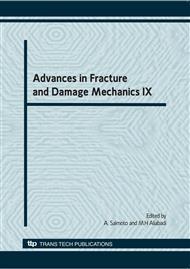p.381
p.385
p.389
p.393
p.397
p.401
p.405
p.409
p.413
Analysis of Fracture Behavior in Polymer Matrix Composites by Infrared Thermography
Abstract:
The tensile fracture behavior of polymer matrix composite materials was investigated with the aid of a nondestructive evaluation (NDE) technique. The materials, E-glass fiber reinforced epoxy matrix composites, which are applicable to bogie materials in railway vehicles to reduce weight, were used for this investigation. In order to explain stress-strain behavior of polymer matrix composite sample, the infrared thermography technique was employed. A high-speed infrared (IR) camera was used for in-situ monitoring of progressive damages of polymer matrix composite samples during tensile testing. In this investigation, the IR thermography technique was used to facilitate a better understanding of damage evolution, fracture mechanism, and failure mode of polymer matrix composite materials during monotonic loadings.
Info:
Periodical:
Pages:
397-400
Citation:
Online since:
November 2010
Authors:
Price:
Сopyright:
© 2011 Trans Tech Publications Ltd. All Rights Reserved
Share:
Citation:


